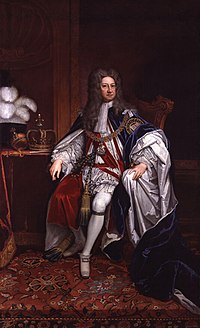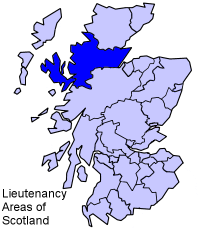
Ross and Cromarty, also referred to as Ross-shire and Cromartyshire, is a variously defined area in the Highlands and Islands of Scotland. There is a registration county and a lieutenancy area in current use, the latter of which is 8,019 square kilometres in extent. Historically there has also been a constituency of the Parliament of the United Kingdom, a local government county, a district of the Highland local government region and a management area of the Highland Council. The local government county is now divided between two local government areas: the Highland area and Na h-Eileanan Siar. Ross and Cromarty border Sutherland to the north and Inverness-shire to the south.

Clan MacLeod is a Highland Scottish clan associated with the Isle of Skye. There are two main branches of the clan: the MacLeods of Harris and Dunvegan, whose chief is MacLeod of MacLeod, who are known in Gaelic as Sìol Tormoid ; the Clan MacLeod of Lewis and Raasay, whose chief is MacLeod of The Lewes, are known in Gaelic as Sìol Torcaill. Both branches claim descent from Leòd, a Norse-Gael who lived in the 13th century.

Skye and Lochalsh is one of eight former local government districts of the two-tier Highland region of Scotland. The main offices of the Skye and Lochalsh district council were in Portree, on the Isle of Skye.

Eilean Donan is a small tidal island situated at the confluence of three sea lochs in the western Highlands of Scotland, about 1 kilometre from the village of Dornie. It is connected to the mainland by a footbridge that was installed early in the 20th century and is dominated by a picturesque castle that frequently appears in photographs, film and television. The island's original castle was built in the thirteenth century; it became a stronghold of the Clan Mackenzie and their allies, the Clan MacRae. In response to the Mackenzies' involvement in the Jacobite rebellions early in the 18th century, government ships destroyed the castle in 1719. The present-day castle is Lieutenant-Colonel John Macrae-Gilstrap's 20th-century reconstruction of the old castle.

Clan Donald, also known as Clan MacDonald, is a Highland Scottish clan and one of the largest Scottish clans. The Lord Lyon King of Arms, the Scottish official with responsibility for regulating heraldry in that country, issuing new grants of coats of arms, and serving as the judge of the Court of the Lord Lyon, recognises under Scottish law the High Chief of Clan Donald. Historically the chiefs of the Clan Donald held the title of Lord of the Isles until 1493 and two of those chiefs also held the title of Earl of Ross until 1476. Queen Mary of Denmark is member of Clan Donald.
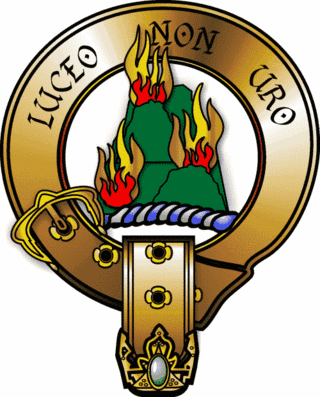
Clan Mackenzie is a Scottish clan, traditionally associated with Kintail and lands in Ross-shire in the Scottish Highlands. Traditional genealogies trace the ancestors of the Mackenzie chiefs to the 12th century. However, the earliest Mackenzie chief recorded by contemporary evidence is Alexander Mackenzie of Kintail who died some time after 1471. Traditionally, during the Wars of Scottish Independence, the Mackenzies supported Robert the Bruce, but feuded with the Earls of Ross in the latter part of the 14th century. During the 15th and 16th-centuries the Mackenzies feuded with the neighboring clans of Munro and MacDonald. In the 17th century the Mackenzie chief was made Earl of Seaforth in the peerage of Scotland. During the Scottish Civil War of the 17th century the Mackenzies largely supported the Royalists. During the Jacobite rising of 1715 the chief and clan of Mackenzie supported the Jacobite cause. However, during the Jacobite rising of 1745 the clan was divided with the chief, Kenneth Mackenzie, Lord Fortrose, supporting the British-Hanoverian Government and his relative, George Mackenzie, 3rd Earl of Cromartie, supporting the Jacobites.

The Clan Macrae is a Highland Scottish clan. The clan has no chief; it is therefore considered an armigerous clan.

Clan MacDonell of Glengarry, also known as Clan Ranald of Knoydart & Glengarry is a Scottish clan and is a branch of the larger Clan Donald. The clan takes its name from River Garry where the river Garry runs eastwards through Loch Garry to join the Great Glen about 16 miles (25 km) north of Fort William, Highland. The progenitor of the MacDonells of Glengarry is Reginald, 4th great-grandson of the warrior Somerled. The clan chief is traditionally designated as the "Son of Alexander's son".

Strome Castle is a ruined castle on the shore of Loch Carron in Stromemore, 3.5 miles south-west of the village of Lochcarron, on the headland between Loch Carron and Loch Kishorn, on the west coast of the Scottish Highlands.

Clan Macdonald of Sleat, sometimes known as Clan Donald North and in Gaelic Clann Ùisdein, is a Scottish clan and a branch of Clan Donald—one of the largest Scottish clans. The founder of the Macdonalds of Sleat was Ùisdean, or Hugh, a 6th great-grandson of Somerled, a 12th-century Lord of the Isles. The clan is known in Gaelic as Clann Ùisdein, and its chief's Gaelic designation is Mac Ùisdein, in reference to the clan's founder. Both the clan and its clan chief are recognised by the Lord Lyon King of Arms, who is the heraldic authority in Scotland.
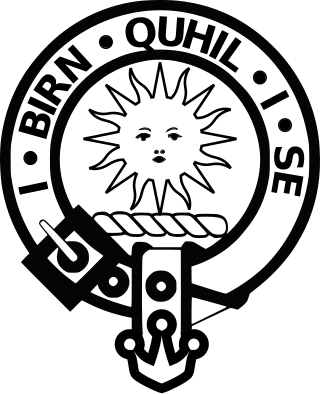
Clan MacLeod of The Lewes, commonly known as Clan MacLeod of Lewis, is a Highland Scottish clan, which at its height held extensive lands in the Western Isles and west coast of Scotland. From the 14th century up until the beginning of the 17th century there were two branches of Macleods: the MacLeods of Dunvegan and Harris ; and the Macleods of the Isle of Lewis. In Gaelic the Macleods of Lewis were known as Sìol Thorcaill, and the MacLeods of Dunvegan and Harris were known as Sìol Thormoid.

Clan Matheson is a Highland Scottish clan.

Ardelve is a village in Highland, Scotland, on Loch Alsh. It overlooks the Eilean Donan Castle, which is in Dornie, also on Loch Alsh, to the east of Skye. A caravan park, several guest houses, a bakery, and pizzeria are located within Ardelve.
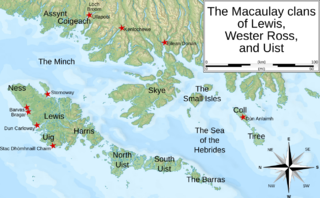
The Macaulay family of Uig in Lewis, known in Scottish Gaelic as Clann mhic Amhlaigh, were a small family located around Uig on the Isle of Lewis in the Outer Hebrides of Scotland. There is no connection between the Macaulays of Lewis and Clan MacAulay which was centred in the Loch Lomond area, bordering the Scottish Highlands and Scottish Lowlands. The Macaulays of Lewis are generally said to be of Norse origin because of the etymology of their surname and also because of the islands' Viking Age past. However, a recent analysis of the Y-DNA of men with Scottish surnames has shown that a large number of Hebridean Macaulays are of Irish origin. In the 17th century, however, tradition gave the Macaulays an Irish origin. By the end of the 16th century the dominant clan on Lewis was Clan Macleod of The Lewes. Other notable Lewis clans were the somewhat smaller Morrisons of Ness and the even less numerous Macaulays of Uig. The Macaulays were centred in the area surrounding Uig on the western coast of Lewis, and had a deadly, long-standing feud with the Morrisons, whose lands were located on the northern coast around Ness. Today the Lewis surname Macaulay is considered to be a sept name of the Macleods of Lewis. There are two other nearby clans of Macaulays who may, or may not, be connected to the Lewis clan—the Wester Ross Macaulays, and the Uist MacAulays.
Kenneth Mackenzie, the first Lord Mackenzie of Kintail, was a Highland clan chief who secured for himself and his heirs the entirety of the Isle of Lewis in the Outer Hebrides and successfully pursued a bloody feud with the Macdonells of Glengarry.
Colin Mackenzie, 1st Earl of Seaforth (1596/97–1633), was a Highland clan chief and Scottish nobleman, possessed of vast estates and wealth.

The Isle of Skye, or simply Skye, is the largest and northernmost of the major islands in the Inner Hebrides of Scotland. The island's peninsulas radiate from a mountainous hub dominated by the Cuillin, the rocky slopes of which provide some of the most dramatic mountain scenery in the country. Although Sgitheanach has been suggested to describe a winged shape, no definitive agreement exists as to the name's origins.
Lieutenant Colonel John MacRae-Gilstrap was a British army officer and a senior figure of the Clan Macrae. He contested a rival claim to the chiefship of the clan, and in 1912 he purchased and subsequently restored the Macrae stronghold of Eilean Donan Castle on Loch Duich in the west of Scotland.
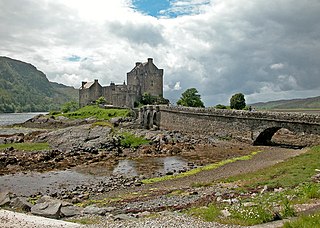
The Capture of Eilean Donan Castle was a land-based naval engagement that took place in 1719 during the British Jacobite rising of that year, and the War of the Quadruple Alliance. A British naval reconnaissance force of three ships attacked the castle of Eilean Donan on the west coast of Scotland, which was held by Spanish troops. After a naval bombardment, the British government forces stormed the castle, and the defenders surrendered. The castle was subsequently destroyed with gunpowder.
The Murchison family of Loch Alsh, Ross-shire, Scotland were a minor Scottish clan, and a sept of the larger Clan Mackenzie. In modern times the Murchison surname is still considered a sept of the Clan Mackenzie by the Clan Mackenzie Society of Scotland & the UK.


